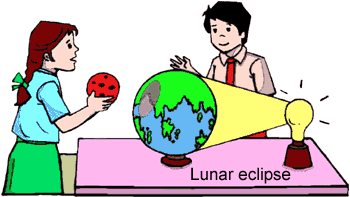BACKGROUND:
 A solar eclipse takes place when the Moon comes
between the Sun and Earth. The Moon thus casts a shadow on the
"daytime" part of the Earth. Because the Moon is small compared to
the Earth, only a limited portion of the Earth experiences the eclipse.
Viewed from Earth, the Moon appears to move in front of the Sun for a period
of minutes to hours. It becomes as dark as night if the Sun is fully
blocked, or partially dark if the eclipse is incomplete.
A solar eclipse takes place when the Moon comes
between the Sun and Earth. The Moon thus casts a shadow on the
"daytime" part of the Earth. Because the Moon is small compared to
the Earth, only a limited portion of the Earth experiences the eclipse.
Viewed from Earth, the Moon appears to move in front of the Sun for a period
of minutes to hours. It becomes as dark as night if the Sun is fully
blocked, or partially dark if the eclipse is incomplete.
When the Earth is between the Sun and the Moon, a
lunar eclipse can occur. The Earth blocks off the sunlight from the Moon.
This may cast the Moon into total darkness, or if the eclipse is partial,
the Moon may glow a dark red color.
When the Moon is not aligned with the Sun and Earth,
only part of it is visible. The Moon revolves counterclockwise around the
Earth. From the time of a new Moon, when no portion of it is visible, the
Moon increases in size. The right side of the Moon becomes visible first.
The Moon grows to its full size, and then shrinks. Shadows also progress
across the Moon from right to left.
PROCEDURE:
- The book, Eclipse: Darkness in Daytime
describes how scientists predict when an eclipse will take place and
where the Moon's shadow will fall. Read Eclipse: Darkness in Daytime
to the class. Make sure the students understand what an eclipse is.
Explain how the appearance of the Moon changes as it rotates around the
Earth. It may help to draw diagrams on the board.
- Set up the planetarium as shown in the diagrams
below. Ask the students the questions that follow, and have them answer
them out loud. The answers are given below in parentheses.
General questions:
(1) Ask the students how many planets are shown on the model. (2) Have the
students name them. (Venus, Earth) (3) Which inner planets are missing?
(Mercury and Mars). (4) Which planet on this model receives the most heat
from the Sun? (5) (Venus is the closest on this model.)
Diagram A: Are there
any areas of the Earth and Moon that are not receiving sunlight? What is
it called when this happens? (Yes, part of the Earth is in shadow. This is
called a solar eclipse).
Diagram B: Are there
any areas of the Earth and Moon that are not receiving any sunlight? What
is it called when this happens? (Yes, this time part of the Moon is in
shadow. This is called a lunar eclipse).
Diagram C: How much of
the Moon is visible from Earth? (Half) Make sure the students see that the
right half of the Moon is visible.
Diagram D: How much of
the Moon is visible from Earth? Is it the same part of the Moon as in the
last question? (Half of the Moon is visible again. No, the left half of
the Moon can be seen this time.)